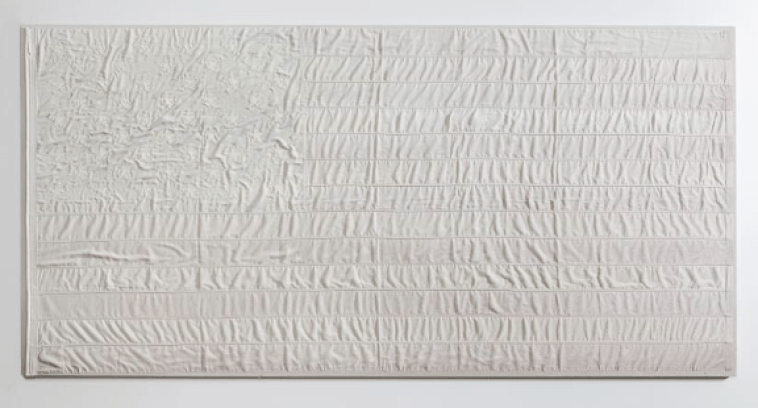Of our many workings of the material, flags have long held significant importance as symbols of national identity, sovereignty, and unity. Even as we collectively and individually contemplate (and often wrestle with) its meaning, the U.S. flag continues to exist as a poignant source of creative inspiration.

Photo: Robert Wedemeyer
As sign and symbol, the United States flag is decidedly not neutral. It is both charged and charging; a demonstration of politics, position, and presence. And yet, ask ten individuals what the nation’s flag truly means, and you are likely to encounter ten different and disparate answers—none less real than the other. Writing for Art Forum in 2006, Anne M. Wagner reminds us of The Americans, a highly influential portrayal of post-war America in which the photographer Robert Frank offers a broad and nuanced portrayal of the era. In these works, the inconsistent totality of the country was laid bare – the “EVERYTHING-ness” of America as Jack Kerouac would respond, made possible through and by our vast differences.

stitched with rows of white stars commemorating the number of individuals shot and killed in the
United States in 2018. Courtesy the artist and Jack Shainman Gallery
To consider how creatives have interpreted and then reinterpreted the flag is to actually initiate a much more complex series of questions. What is the historical and current relationship between the artist and this nation? What has shaped that relationship? What has shaped that artist’s sense of self, place and belonging on this land? For many, the flag’s potency lies in its capacity to generate national pride and materialize resistance in the face of adversity. For some, it is a beacon of hope, and for others still, it is representative of longstanding histories of imperialism, racism, sexism, and
homophobia that continue to unfold and complicate our relationship with the red, white, and blue. Through deconstructing, subverting, and recontextualizing the flag, artists continue to challenge, expose, and advocate for a national experiment that held a promise of equality and justice for all.

Alternative representations of the flag offer us, the people, an important opportunity for critical dialogue around not just our differences—our “everythingness”—but also our collective persistence of presence. Through their engagement with this symbol, artists pointedly mark a place on this land; quite literally planting a flag through both time and space. From William Pope.L’s Trinket, a 45-foot-long U.S. flag subjected to high velocity
winds until tattered, to Yvonne Rainer’s Trio A with American Flags, artists have borne a bold and perhaps deeply patriotic willingness to test the limits of one of the country’s most powerful symbols. Throughout the ongoing making and unmaking of this country, artists and creatives have turned to the material possibilities of the flag to not only negotiate those differences, but to consider what also might bind us to it and to each other into the future.
Lauren Baccus, Digital Content Editor TSA

You must be logged in to post a comment.